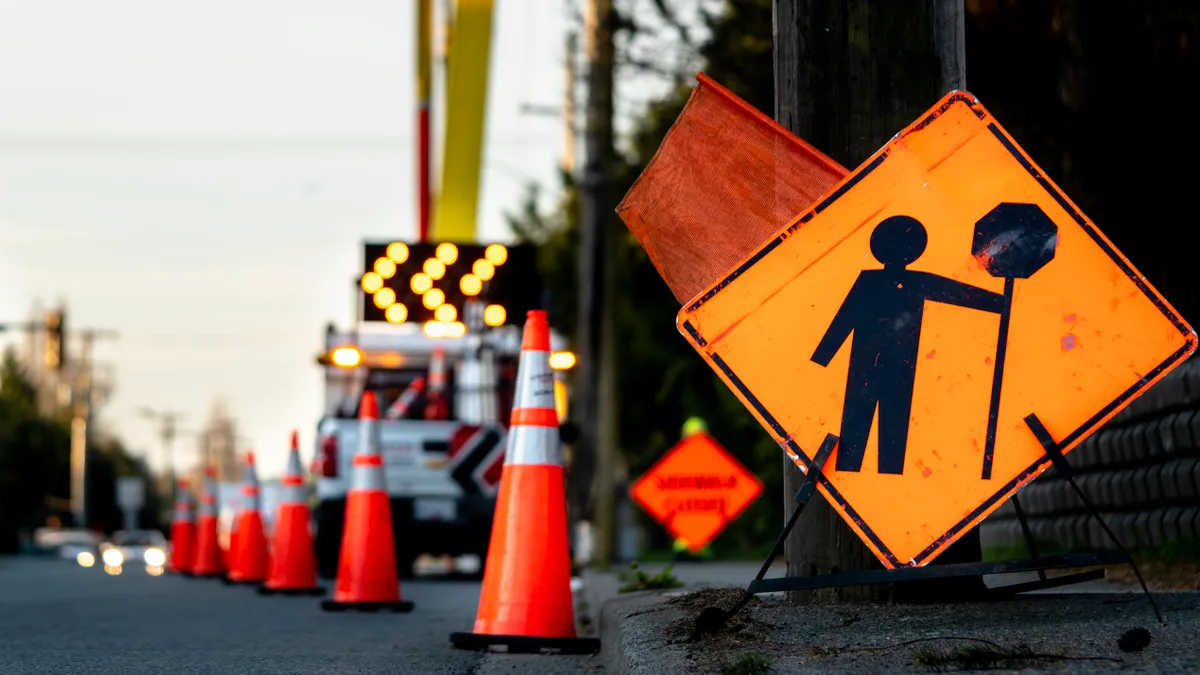When a motorist on a highway near Baltimore tried to switch lanes, she collided with another car then careened into a work zone through an opening in a temporary concrete barrier, killing six construction workers last month.
Highway work zone safety is under a new, glaring spotlight after the crash on I-695.
“By all indications it was a horrific crash,” David McKee, vice president of marketing and government relations at traffic safety firm PSS, told the Washington Post. “Typically, if a car somehow gets inside or past the barrier into the protected workspace, there’s no place for it to go.”
It’s not an isolated incident — even on I-695. A few weeks after the March incident, another driver rear-ended a Maryland State trooper who was in a work zone 20 miles away along the same stretch of highway.
Work zone crashes continue to be a fatal problem, one that could ramp up as spring and summer highway work is now beginning across the country.
In 2020, 857 people were killed and 44,000 injured in work zone crashes, according to the National Work Zone Safety Information Clearing House. More recently, the 2022 Work Zone Awareness Survey found that 64% of firms working on highway upgrades experienced car crashes over a 12-month period, and 32% of respondents had five or more motor vehicle crashes at their highway work zone in the previous 12 months.
It’s an issue that may also be exacerbated by the Infrastructure Investment and Jobs Act, which is providing $110 billion in funding for roads and bridges. More people will work at risk in these kinds of environments.
Solutions to slow drivers can come from multiple fronts, including driver awareness, more and better use of law enforcement and speed tracking technology or simply enforcing directives already in place, experts say.
Forcing drivers to slow down
Working along highways is inherently risky, said Brian Turmail, vice president of public affairs and strategic initiatives at Associated General Contractors of America.
“There’s really no other environment that you can think of where you’ve got cars and trucks speeding by at 80 miles per hour within inches of where you’re working,” he said.
However, cars and trucks should not be going past at 80 mph in these areas. Quite simply, improving safety means forcing drivers to slow down.
One way to do that is through steeper fines for speeding in work zones, Turmail said. In Maryland, that fine is only $40. In Illinois, it’s $375 for the first offense and a minimum of $1,000 for the second. A Missouri law made “endangerment of a highway worker,” a crime; speeding in a work zone could result in fines of $1,000 if no injury takes place, and up to $5,000 or $10,000 if a worker is injured or killed, respectively.
Another tactic is deploying speed cameras in work zones, which Turmail says member organizations have had trouble securing, despite the cameras’ effectiveness. He cites Pennsylvania’s Automated Work Zone Safety Enforcement Program. In 2021, the first full year it was in place, work zone speeding dropped by 20%, with 100 fewer crashes and a 25% drop in fatal crashes in work zones.
While the DOT has authorized funding for concrete Jersey barriers in construction zones, they don’t mandate it be used for that purpose.
“Because Jersey barriers tend to cost more than orange barrels, some states prefer to husband their road funds and only install other forms of barriers,” like the orange barrels, which are less effective, safety wise, Turmail said.
Drivers also at risk
The idea of forcing drivers to slow down is not a popular one in the U.S., and one that many politicians won’t back if doing so carries a whiff of infringing on someone’s individual rights, even if it’s dangerous.
John Davis, retired American Public Works Association government affairs committee member and public works engineer, said that he believes politicians want work zones to be safe, “but they also don’t want to impede on the rights of the general public,” he said.
“When you think about things like employing speed cameras to enforce speed limits through construction zones, that becomes a real quandary for some of our elected officials,” Davis said.
AGC has worked to educate drivers, not just about how they put workers at risk if they speed or don’t pay attention while navigating work zones, but also the risk they put upon themselves and that they are statistically more likely to die in a work zone crash.
Of the 857 work zone crash fatalities in 2020, 117 were workers. The rest were drivers, passengers and pedestrians. Even if the message is self-serving, “save yourself and the people around you” can work, Davis said.
As is reminding drivers what’s at stake, and how little they have to gain by zipping through a work zone.
“We don’t realize that if we drive through a 5-mile construction zone at 70 mph versus 40 mph, it takes just over three minutes longer to get through those five miles,” Davis added. “So is that three minutes worth our safety and the safety of the workers along the way? Probably so.”




















